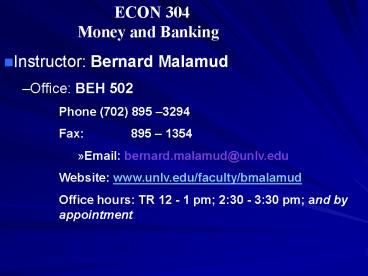Chapter 1 An Introduction to Money and the Financial System - PowerPoint PPT Presentation
1 / 25
Title:
Chapter 1 An Introduction to Money and the Financial System
Description:
... and make loans ... Great Depression and clogged credit channel. Core Principles of ... Adverse Selection (before the transaction) more likely to select ... – PowerPoint PPT presentation
Number of Views:285
Avg rating:3.0/5.0
Title: Chapter 1 An Introduction to Money and the Financial System
1
- ECON 304 Money and Banking
- Instructor Bernard Malamud
- Office BEH 502
- Phone (702) 895 3294
- Fax 895 1354
- Email bernard.malamud_at_unlv.edu
- Website www.unlv.edu/faculty/bmalamud
- Office hours TR 12 - 1 pm 230 - 330 pm and
by appointment
2
Money, Banking, and Financial Markets
- The role of money and monetary policy in the
economy - TRUST
- How financial markets such as bond, stock and
foreign exchange markets work - TRUST
- How financial institutions such as banks and
insurance companies work - TRUST
3
- A security (financial instrument) is a claim on
the issuers future income or assets - A bond is a debt security that promises to make
specified payments over time - An interest rate is the cost of borrowing or the
price paid for the rental of funds - Common stock represents a share of ownership in a
corporation - A share of stock is a claim on the earnings and
assets of the corporation
4
(No Transcript)
5
(No Transcript)
6
(No Transcript)
7
Banking and Financial Institutions
- Financial Intermediariesinstitutions that borrow
funds from people who have saved and make loans
to other people and businesses - Banksaccept deposits and make loans
- Other Financial Institutionsinsurance companies,
finance companies, pension funds, mutual funds
and investment banks - Financial Innovation
- The information age and e-finance
- Derivatives
- Securitization
8
Money and Business Cycles
- Recessions (unemployment) and booms (inflation)
affect all of us - Monetary Theory ties changes in the money supply
to changes in aggregate economic activity and the
price level
9
Money and Inflation
- The aggregate price level is an average price of
goods and services in an economy - A continual rise in the price level (inflation)
affects all economic players
10
Monetary and Fiscal Policies
- Monetary policy is the management of the money
supply and interest rates - Conducted by the Federal Reserve Bank (Fed)
- Fiscal policy is government spending and taxation
- Any deficit must be financed by borrowing
government borrowing affects interest rates
11
Bernankes Focus
- Inflation Targeting
- Adjust real rate of interest with eye on
pre-announced target rate of inflation - Wiggle room for other objectives/emergencies
- Transparency and accountability
- Joined by Mishkin on Board of Governors
- Other Governors
- www.federalreserve.gov/bios
- Oppose Deflation
- Great Depression and clogged credit channel
12
Core Principles of Money and Banking
- Time has Value ? Interest rate
- Risk Requires Compensation
- Financial decisions are based on Information and
on TRUST - Markets set prices and allocate resources
- Stability reduces risk and spurs enterprise
13
(No Transcript)
14
Where to Find the Numbers
- http//research.stlouisfed.org/fred2/
- www.federalreserve.gov/releases/
- www.economist.com
- www.bea.doc.gov
- http//www.gpoaccess.gov/eop/
15
Function of Financial Markets
- Channel funds from economic players that have
saved surplus funds to those that have a shortage
of funds - Promotes economic efficiency by producing an
efficient allocation of capital - increases production
- Improves consumer well-being
- allows them to time purchases better
16
(No Transcript)
17
Structure of Financial Markets
- Debt and Equity Markets
- Primary and Secondary Markets
- Investment Banks underwrite securities in primary
markets - Brokers and dealers work in secondary markets
- Exchanges and Over-the-Counter (OTC) Markets
- Money and Capital Markets
- Money markets deal in short-term debt instruments
- Capital markets deal in longer-term debt and
equity instruments
18
(No Transcript)
19
(No Transcript)
20
Internationalization of Financial Markets
- Foreign Bondssold in a foreign country and
denominated in that countrys currency - Eurobondbond denominated in a currency other
than that of the country in which it is sold - Eurocurrenciesforeign currencies deposited in
banks outside the home country - EurodollarsU.S. dollars deposited in foreign
banks outside the U.S. or in foreign branches of
U.S. banks - World Stock Markets
21
Function of Financial Intermediaries Indirect
Finance
- Lower transaction costs
- Economies of scale
- Liquidity services
- Reduce Risk
- Risk Sharing (Asset Transformation)
- Diversification
- Asymmetric Information
- Adverse Selection (before the transaction)more
likely to select risky borrower - Moral Hazard (after the transaction)less likely
borrower will repay loan
22
(No Transcript)
23
(No Transcript)
24
Regulation of the Financial System
- To increase the information available to
investors - Reduce adverse selection and moral hazard
problems - Reduce insider trading
- To ensure the soundness of financial
intermediaries - Restrictions on entry
- Disclosure
- Restrictions on Assets and Activities
- Deposit Insurance
- Limits on Competition
- Restrictions on Interest Rates
25
(No Transcript)































